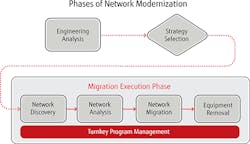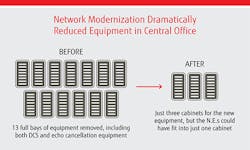Partnering for Success
For wired and wireless operators, meeting subscriber expectations often calls for modernizing an outdated, expensive network that was not designed for today’s technology and business environment. And while network modernization results in many benefits, it must be approached in a way that ensures live traffic is uninterrupted and goals are achieved within budget.
Digital Cross Connect Systems (DCS), Synchronous Optical Network (SONET) systems and Time Division Multiplexing (TDM) switches are just 3 of the technologies that are currently being modernized by operators today. When wireless service providers make the transition from TDM to IP to increase capacity and reduce cost, they free up TDM ports in wireless central offices. These ports are now sitting idle, taking up space and using power that could be put toward next-generation networks.
These legacy systems drain budget and opportunity. They occupy costly floor space; use excessive power, including requiring significant HVAC; tap limited resources for operation and maintenance; and act as barriers to implementing next-generation services. The days of the big, single application machines are over; the platforms that are most often recommended during network modernization are designed to be multi-service, delivering a variety of functions in a single system.
Step-by-step: the phases of Network Modernization.
Engineering Analysis and Strategy Determination
Many of the legacy systems found in operators’ networks today are based on technologies that were designed and implemented in the 1980s or even earlier. They exist throughout the network, often acting as critical routing points for traffic that is traversing cities and states. As these technologies age and operators become interested in network modernization, they frequently need a trusted partner to work with them to handle all or part of the network modernization process. While the operator is busy with the day-to-day operations of maintaining their network and keeping millions of customers happy, the partner can focus on upgrading the network and seamlessly migrating the network traffic to the new platforms.
An added twist to network modernization is that it requires staff with specialized expertise and experience on both the new systems being deployed as well as the legacy systems being replaced. It’s not unusual for operators to lack employees with experience working on both legacy and next-generation technologies, and a partner can provide that missing skill set. Because of the pressures of time and the variety of technologies at play, an experienced and trusted partner can be key to a successful network modernization.
When working with a modernization partner, it’s important to begin with a shared understanding of the goals and objectives, as well as a timeline and, of course, budget. Before any work begins, the modernization partner should begin the process by actively listening to the operator to internalize what they’re trying to achieve, understand the problems they’re facing, and understand what the desired outcomes are.
The modernization partner should be intimately familiar with the network architecture and the various vendors’ networking equipment. An initial on-site visit is recommended to conduct a high-level analysis of targeted systems and to gain a better understanding of potential migration and optimization strategies. Throughout this engineering analysis phase, your partner should have a vendor-agnostic point-of-view, recommending new solutions based only on their appropriateness for the network, not on an allegiance to any one brand over another. Once the engineering analysis is delivered, the operator reviews all options and selects the best strategy for their needs and desired outcomes.
The network discovery phase includes an electronic audit of the current network state and a physical audit of the central office. It creates a realistic baseline from which modernization work can ensue. It should be a comprehensive analysis and include examining documentation of legacy systems, network topologies, inventory databases, circuit types and utilization, fiber types and connectors, end-to-end connectivity, and optical and electrical cabling.
Leveraging Network Modernization leads to substantial savings in floor space.
Network Analysis
With the network discovery complete, the next phase is network analysis. Your modernization partner will determine the best method for migration. They will then provide a site-specific detailed Method of Procedure (MOP), confirm all material requirements for migration, create a master design sheet, and finalize the project timeline and resource requirements.
The master design sheet should detail the following items:
• Full port correlations between old and new systems
• Fully scripted commands for provisioning and migration
• Detailed patch and rewire information
• Fiber jumper run list including length, quantity, and connector types
Network Analysis creates everything needed for a successful network migration.
Network Migration
The network migration itself is now ready to be performed. It must be done efficiently and with care so that live traffic continues uninterrupted. Your modernization partner should have a proven ability to successfully cut-over live traffic in accordance with the MOP and establish new traffic connections, properly documented with accurate and updated circuit records.
Now it’s time to reap the benefits! Once the operator has modernized their networks, they will be able to support the highly-profitable IP services their customers demand, implement Cloud strategies, make more efficient use of their bandwidth, and add flexibility to their networks, while also eliminating manufacturer-discontinued or failing systems. And an experienced network modernization partner can enable these benefits with a faster time-to-completion.
That said, don’t rush into the partner selection process with haste. This is a critical step in ensuring the overall success of the network modernization effort. When evaluating partners, operators should look for those that actively listen first to the customer, can offer a team with a successful track-record, and will recommend and implement the best solutions regardless of the manufacturer.
Real-World Example
Let me offer a real-world example. Recently, a major wireless operator determined that their network needed to be upgraded for a number of typical reasons, including the high cost of maintaining their legacy equipment. They knew their installed network equipment was:
• Reaching sunset stage in the manufacturer’s product lifecycle.
• Occupying costly floor space in their Central Office (CO).
• Operating significantly below traffic capacity.
• Utilizing excessive power resulting in high energy costs.
• Requiring costly ongoing operation and maintenance services.
• A barrier to implementing new technologies.
• They could not find and retain technicians with legacy network experience.
The Tier 1 wireless operator wanted a turnkey partner that offered a multi-vendor solution as well as a range of professional services, network engineering, and traffic migration services. They also wanted a certified project manager to oversee the whole project and serve as their single point of contact for the project.
After completing an in-depth evaluation at the operator’s location, including an extensive review of installed equipment, the partner recommended 3 different migration options that were appropriate for the needs and desired outcomes of the operator. Once the wireless operator selected their desired option, the partner developed a scope of work and assembled the right team to complete the work correctly without any service disruptions and within the operator’s budget. The outcome for the operator was a modernized transport network that uses multi-service platforms that provides greater network flexibility.
The end result was an approximately 85% reduction in number of cabinets needed which led to a substantial savings in floor space as well as a 7x reduction in system power and related HVAC savings. They also improved their network performance and reliability, gained greater operational efficiencies, decreased the operation and maintenance costs associated with the legacy equipment, and reclaimed spares that can be used in other areas of the network.
Clearly, the right partner and a proven approach to network modernization can make all the difference.
Save
About the Author



